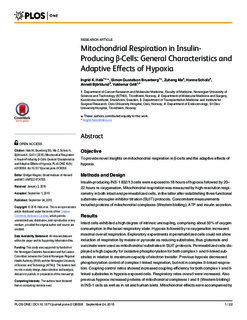| dc.contributor.author | Hals, Ingrid Katrin | |
| dc.contributor.author | Bruerberg, Simon Gustafson | |
| dc.contributor.author | Ma, Zuheng | |
| dc.contributor.author | Scholz, Hanne | |
| dc.contributor.author | Björklund, Anneli | |
| dc.contributor.author | Grill, Valdemar Erik Robert | |
| dc.date.accessioned | 2015-11-17T14:10:22Z | |
| dc.date.accessioned | 2015-11-18T10:02:17Z | |
| dc.date.available | 2015-11-17T14:10:22Z | |
| dc.date.available | 2015-11-18T10:02:17Z | |
| dc.date.issued | 2015 | |
| dc.identifier.citation | PLoS ONE 2015 | nb_NO |
| dc.identifier.issn | 1932-6203 | |
| dc.identifier.uri | http://hdl.handle.net/11250/2364454 | |
| dc.description.abstract | Objective:
To provide novel insights on mitochondrial respiration in β-cells and the adaptive effects of
hypoxia.
Methods and Design
Insulin-producing INS-1 832/13 cells were exposed to 18 hours of hypoxia followed by 20–
22 hours re-oxygenation. Mitochondrial respiration was measured by high-resolution respirometry
in both intact and permeabilized cells, in the latter after establishing three functional
substrate-uncoupler-inhibitor titration (SUIT) protocols. Concomitant measurements
included proteins of mitochondrial complexes (Western blotting), ATP and insulin secretion.
Results:
Intact cells exhibited a high degree of intrinsic uncoupling, comprising about 50% of oxygen
consumption in the basal respiratory state. Hypoxia followed by re-oxygenation increased
maximal overall respiration. Exploratory experiments in peremabilized cells could not show
induction of respiration by malate or pyruvate as reducing substrates, thus glutamate and
succinate were used as mitochondrial substrates in SUIT protocols. Permeabilized cells displayed
a high capacity for oxidative phosphorylation for both complex I- and II-linked substrates
in relation to maximum capacity of electron transfer. Previous hypoxia decreased
phosphorylation control of complex I-linked respiration, but not in complex II-linked respiration.
Coupling control ratios showed increased coupling efficiency for both complex I- and IIlinked
substrates in hypoxia-exposed cells. Respiratory rates overall were increased. Also
previous hypoxia increased proteins of mitochondrial complexes I and II (Western blotting)
in INS-1 cells as well as in rat and human islets. Mitochondrial effects were accompanied by unchanged levels of ATP, increased basal and preserved glucose-induced insulin
secretion.
Conclusions:
Exposure of INS-1 832/13 cells to hypoxia, followed by a re-oxygenation period increases
substrate-stimulated respiratory capacity and coupling efficiency. Such effects are accompanied
by up-regulation of mitochondrial complexes also in pancreatic islets, highlighting
adaptive capacities of possible importance in an islet transplantation setting. Results also
indicate idiosyncrasies of β-cells that do not respire in response to a standard inclusion of
malate in SUIT protocols. | nb_NO |
| dc.language.iso | eng | nb_NO |
| dc.publisher | Public Library of Science | nb_NO |
| dc.title | Mitochondrial Respiration in Insulin-Producing β-Cells: General Characteristics and Adaptive Effects of Hypoxia | nb_NO |
| dc.type | Journal article | nb_NO |
| dc.type | Peer reviewed | en_GB |
| dc.date.updated | 2015-11-17T14:10:22Z | |
| dc.source.journal | PLoS ONE | nb_NO |
| dc.identifier.doi | 10.1371/journal.pone.0138558 | |
| dc.identifier.cristin | 1290053 | |
| dc.description.localcode | © 2015 Hals et al. This is an open access article distributed under the terms of the Creative Commons Attribution License, which permits unrestricted use, distribution, and reproduction in any medium, provided the original author and source are credited. | nb_NO |
